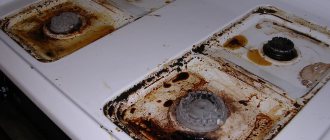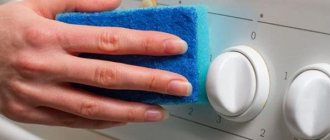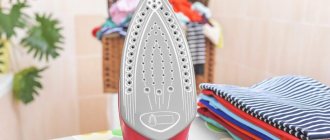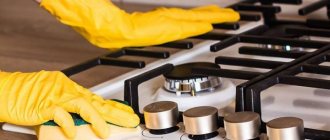/Order/
All manufacturers recommend cleaning glass-ceramic hobs only with soap solutions or special products for glass-ceramics (in the form of creams, pastes or sprays). The latter are good because they not only clean the surface of the slab, but also leave a dirt-repellent film on it and add shine.
But what to do if there is no special cleaner at hand or it simply cannot remove stubborn stains? In this case, you will be helped by the products in your medicine cabinet or kitchen cabinet, as well as our tips on choosing more effective products for glass ceramics.
If you have a gas stove, see the material: How to clean a gas stove in 8 steps
Method 1. How to care for a glass-ceramic stove every day
This method is the only one that all manufacturers of glass-ceramic stoves officially allow for daily cleaning.
Instructions:
- After cooking (or while cooking), while the stove is still hot, carefully remove any burnt-on liquids or food debris with a scraper.
- When the stove has cooled down (!), treat the dirty areas with a soapy solution (for example, dishwashing liquid) and scrub them with a not too hard sponge. You can also wash the stove with a wet sponge and laundry soap.
- Remove stubborn stains with a special paste or cream for glass ceramics.
- Wipe the stove clean and dry, removing any remaining product.
Adviсe:
- The soap solution or a foam head from it can be left on the stove for 20-40 minutes. The main thing is that the liquid does not leak outside the stove.
- The main tool for cleaning a glass ceramic hob is a glass scraper. How to use it? Position the scraper at an acute angle to the surface of the slab and simply move it back and forth.
Old carbon deposits
The most difficult thing is to remove old greasy stains that have turned into persistent soot. It must be removed so as not to damage the glass coating. You cannot do without a special silicone scraper and a strong detergent.
You need to do this:
- First, carry out normal cleaning using dishwashing detergent.
- Apply carbon remover liquid (available at every household chemical store) to the surface and leave for 5-15 minutes.
- Wipe everything with a damp sponge.
- Use a scraper to remove softened carbon deposits.
- Wipe off any remaining dirt with a clean cloth, and finally wipe the surface with microfiber.
- Polish the glass ceramic with a cellulose cloth until it looks like new.
Method 2. How to clean a glass-ceramic stove with soda
We would like to warn you right away: all manufacturers prohibit the use of soda for washing glass ceramics due to its abrasive properties (micro scratches remain on the surface, due to which the shine is somewhat lost). However, as practice shows, soda does not cause significant harm, and most users use it to wash glass ceramics regularly. If your stove is very dirty and you don't have anything on hand, you can try this cleaning method.
Due to its alkaline properties, it copes well with old carbon deposits, dirt and grease.
Instructions:
- Sprinkle baking soda over the entire surface of the stove.
- In a small bowl, prepare a solution of hot water and dishwashing liquid.
- Soak a towel thoroughly in the soapy solution and completely cover the stove with it as shown in the photo.
- Leave the towel on for 15-30 minutes to loosen stains.
- Rub the surface of the stove with the same towel, using the remaining soda as a tool against soot and dirt.
- Wash and wipe the glass ceramics thoroughly and dry. If desired, use 9% vinegar to remove baking soda residue faster.
Adviсe:
- Instead of one large towel, you can use two small ones.
- The towel should be wet enough to dissolve the baking soda and wet the surface, but not so wet that puddles form and water runs off the stove.
- This cleaning method can be used immediately after method No. 3 (see below) - this will make cleaning even more effective.
- Particularly stubborn stains can be removed with soda paste (soda + water in a 1:1 ratio). In this video you can see how to clean a glass-ceramic stove with soda paste.
What absolutely should not be used when cleaning glass ceramics
There are a number of tools and products that are strictly contraindicated for glass-ceramic surfaces. This includes:
- kitchen knives or other sharp metal objects;
- hard sponges, brushes or washcloths;
- powdered abrasive agents;
- aerosols intended for ovens;
- Dishwashing detergents that leave difficult to remove stains on the surface.
Following simple cleaning rules and using recommended tools and cleaning products will preserve the ceramic panel throughout its entire service life, which, remember, is 15 years. Once again, you can familiarize yourself with the rules for caring for glass ceramics from the presented video.
Method 3. How to wash a glass-ceramic stove using 9% vinegar
Vinegar is an excellent tool for cleaning glass-ceramic hobs from limescale stains and grease. Yes, it is no more effective than dishwashing liquid or a regular spray for cleaning glass ceramics, but it is always on hand and inexpensive.
- When the stove has cooled, spray or dampen stains with 9% table vinegar and wipe the stove with a damp cloth to remove dirt.
- Wipe the stove clean and dry.
Basic Rules
Caring for a household appliance requires care and precision during the procedure.
Requirements for cleaning a ceramic hob:
- Do not start washing the device or applying detergents to the unit until the hob has completely cooled down: the glass ceramics may become cracked as a result of temperature differences;
- even if a strong, ingrained deposit forms on the coating, do not use a knife, steel wool, a brush with stiff bristles or cleaning products with abrasive particles to remove it;
- It is also undesirable to wipe the stove with the same rags or sponges that you use to wash dishes and other items: particles of detergents and fat remaining in the material will leave stains on the smooth surface.
Attention!
After removing dirt, be sure to treat the surface of the device with a rag dampened in clean water and collect any remaining moisture with paper napkins or a towel, since droplets of water, when dried, will also leave noticeable stains on the glass ceramics.
Not only the stove, but also the soleplate of the iron is ceramic. Read about how to clean this household appliance here.
Tips for choosing a glass ceramic cleaner
In the household chemicals department of any store you can find cleaning products for glass ceramics like Cilit Bang, Sanita, Shumanit and others. They are good because they are sold everywhere and are inexpensive (relatively), but they are much less effective than professional glass ceramic cleaners. However, they are still useful to have in your arsenal - for daily cleaning and removing light dirt.
However, if you want to make it as easy as possible to keep your glass-ceramic hob in order or to clean a very neglected glass-ceramic hob, we recommend purchasing a professional product from the manufacturer (not necessarily the manufacturer of your hob). The price of any professional cleaner is high (from 500 rubles), but once you try to clean the stove with it at least once, you will not be able to refuse it.
- For example, very effective products are produced by Electrolux, Indesit, Miele, Korting.
You can buy glass ceramic cleaners in hypermarkets and online stores of household appliances (M.Video, MediaMarkt, etc.).
In the video you can see a review of the Electrolux glass ceramic cleaner.
Adviсe:
- Sprays are convenient to use to remove grease and dirt from the entire surface of a glass-ceramic stove, and pastes and creams come in handy when you need to remove particularly stubborn local dirt around the burners.
- Products containing glycerin or silicone can restore the shine of a glass-ceramic hob and make future cleaning easier.
What can't you do?
Sometimes people make typical mistakes when caring for a glass-ceramic hob, which render it unusable. The main enemies of such a plate are:
- Old rags. If they are dry from age or clogged with dirt, throw them away and get new ones.
- Lack of regular care. You need to clean the surface regularly, otherwise you will not be able to wash it without damaging it.
- Aggressive chemistry. Alkaline products and those containing abrasive particles are dangerous for glass ceramics.
- Hard washcloths and metal mesh.
- Cleaning after use. If the stove has just been hot, allow it to cool completely before cleaning thoroughly, as it is very vulnerable to mechanical and chemical damage.
Careful and regular maintenance will prevent the formation of cracks, which impair the attractive appearance and shorten the service life of the hob.
Tips for caring for a glass ceramic hob
- Try to clean the hob immediately after each use: first with a scraper while the stove is hot, then wash with a cleaner after the surface has completely cooled. Especially quickly you need to remove: melted plastic, plastic film, products containing sugar, such as jam or caramel.
To remove frozen melted plastic, it must be melted again and scraped off
- Do not use aggressive cleaning products such as oven cleaner, bleach, anti-clog cleaner, etc. They may cause blue spots to appear on the stove, which are unlikely to be eliminated.
- Always use pots and pans with clean bottoms.
- It is undesirable to use dishes made of aluminum and copper, as well as enamel dishes, as they leave marks that are difficult, and sometimes simply impossible, to remove.
- Do not use abrasives, hard brushes or sponges.
- Keep in mind that the scraper blade needs to be replaced periodically. One blade lasts for 8-12 months.
- Do not use table knives or any other sharp objects instead of a special glass scraper. What can you use to temporarily replace the scraper? A silicone spatula is ideal for removing fresh dirt.
- After washing the glass-ceramic hob, wipe it dry to prevent limescale and streaks from appearing on it.
Support the project - share the material with your friends on social networks:
What tools to use?
To properly and accurately clean a glass-ceramic stove, you need to use special paraphernalia. Everything you need can be bought in a store or found at home:
- soft sponge;
- container with water;
- microfiber cloth;
- dry wipes;
- cleansers;
- special scraper.
To clean off any dirt without damaging the surface, you need to buy scrapers with thin metal blades - they are replaceable. The tool is suitable for removing dry carbon deposits, but we’ll figure out how to use it later.
There are also melamine sponges that can cope with many stains. It is enough to wet the washcloth and wipe the problem areas with it, and then wash the surface with soapy water.
Why does a glass hob get dirty?
The cooking process doesn't always go perfectly. Grease splashes when frying potatoes or drops of batter when baking pancakes are almost inevitable. Coffee in the Turk or milk set to boil can escape, and if a young cook is in charge of the kitchen, the hob gets dirty with anything: from small pieces of vegetables and their peelings to spilled spices or flour.
Important ! Untimely cleaning leads to irreversible damage to the hob.
A dirty stove is not only an aesthetic problem or a brownie’s dissatisfaction. Sticky dirt will begin to burn, and new layers of food debris will stick to it, no matter how carefully you use the appliance. Dirt will continue to accumulate, and the stove itself will lose its attractiveness and practicality.
Accessories
In addition to cleaning compositions for the stove, every housewife must have a set of special devices on hand.
Among them:
- Scrapers. Made for the care of hobs. Such accessories are blades fixed in a plastic or metal handle-holder, which can be fixed or removable (can be replaced if necessary). Brands: Electrolux, Filtero, Indesit, Top House, Pyramid, GEFU and others.
- Melamine sponges - wipe away dirt (like an eraser). Made from a special synthetic material, they have a mesh structure and have abrasive properties. They are used without cleaning agents (judging by numerous reviews, the sponge itself works better than all formulations). They work with them wearing gloves. It is necessary to buy only certified products. Cheap analogues are unsafe for health and cause allergies.
- Regular foam sponges.
- Microfiber cloths - used to remove dust, stains, polish surfaces and add shine. One side with roughness successfully copes with dirt, the other (smooth) polishes and adds shine. The fabric does not leave streaks, stains, or lint, and works well with silicone-based products. Such napkins are produced by many manufacturers - Top House, Topperr, Filtero (with cleaning thread), Greenway.
Special cases of contamination
Fusible materials such as burnt sugar or plastic should be removed immediately.
Sugar on a hot glass ceramic stove creates a dangerous situation. Manufacturers warn about the destruction of the high-tech coating: the sugar crystal lattice is similar to the surface structure. For this reason, the sugar will burn holes in the surface.
If sugar does get on the stove during cooking, it should be removed while it is still hot or warm, before it has time to harden. You need to unplug the device, remove the melting sugar, and wash the surface with your usual detergent.
Stains caused by melting plastic should be removed before they harden. If, however, the moment is missed, reheat the surface and remove the stain using a cleaning scraper.
If milk has burnt, coffee or jam has escaped, it is recommended to remove these liquids from the hot stove as quickly as possible to avoid crystallization. You can use a scraper to remove the stain from the surface. If a cloth is used, it should not be cold.
If thick organic compounds get on a hot surface, they are difficult to remove with a cloth. It is enough to wait until they burn out to the state of coal, then remove the remains with a metal scraper.
You can care for the glass-ceramic surface using means available to every housewife. With proper care, a glass-ceramic stove will last for decades.










